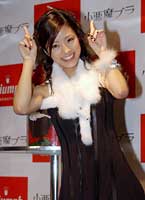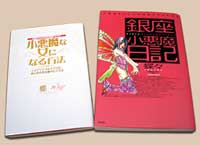|
|
|||||||
|
|
|||||||
|
|||||||
| | Web Japan >> | Trends in Japan >> | Fashion >> | Bad Girls on the Block | |
|
BAD GIRLS ON THE BLOCK "Little Devils" Are Cute and Sexy Both Inside and Out (June 8, 2005) They're cute, they're sexy, and they toy with men's hearts. They're koakuma ("little devils") and they represent a female archetype that has been around for as long as there have been men's hearts to toy with. Although there are little devils in every nation, Japan has recently seen a marked increase in the number of women who actively embrace the "bad girl" ethos. Books and websites on how to live the little-devil lifestyle are flying off the shelves, as are clothes and other goods deemed essential to achieve the little-devil look. What Makes a Little Devil? But the days when little devils were adored by men yet shunned by their fellow females are over. Little devils are now admired by both genders. Japan's little-devil boom can be traced to a how-to book that came out in May 2004. In Koakuma na Onna ni Naru Hoho (How to Become a Little Devil), a woman who used to be an office worker and club hostess before taking up writing under the name Chocho (meaning butterfly) shares her secrets for making men fall like dominoes. Her techniques sum up the universal attributes of the bad girl. According to Chocho, when a guy asks, "Do you like me?" little devils should reply, "Not at all!" The secret to getting someone to like you, says the author, is to behave like a spoiled brat toward that person. As for achieving the little-devil look, women should make their eyes look unforgettable yet somehow mischievous and wear clothes that unabashedly show off their body contours. They should also apply lip gloss and give their lips a sensuous beauty. A how-to book on the subject of love is deemed a hit if it sells 100,000 copies. Koakuma na Onna ni Naru Hoho has sold 200,000, mainly to women in their twenties and thirties. Little-Devil Makeup and Underwear The little-devil craze has spawned a host of products. From wax designed to enable women to keep their little-devil hairstyle perfectly in place to lacy underwear like the "little-devil bra," goods that help girls to achieve this look are selling well. There are of course websites devoted to the little-devil craze. One of these is a horoscope site titled Happy Koakuma, which was launched in October 2004 and can be accessed by users from their mobile phones. Visitors to the site can take a test to determine which of nine little-devil characters they most closely resemble. In the past, little devils have tended to be much less popular with other women than with members of the opposite sex. The recent craze for the little-devil lifestyle and look shows, however, that "bad girls" are now earning admiration among young Japanese women for their no-hold-barred approach to life and love. Copyright (c) 2005 Web Japan. Edited by Japan Echo Inc. based on domestic Japanese news sources. Articles presented here are offered for reference purposes and do not necessarily represent the policy or views of the Japanese Government. |
||
|




